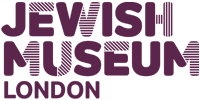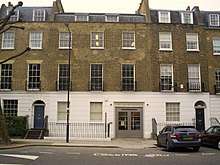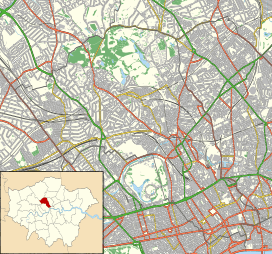Jewish Museum London
The Jewish Museum London is a museum of British Jewish life, history and identity. The museum is situated in Camden Town in the London Borough of Camden, North London. It is a place for people of all faiths to explore Jewish history, culture, and heritage. The museum has a dedicated education team, with an extensive programme for schools, community groups and families. Charles, Prince of Wales is a patron of the museum.[1]
 | |
 Exterior of the Jewish Museum at Raymond Burton House | |
 Location within London Borough of Camden | |
| Location | Raymond Burton House 129–131 Albert Street London, NW1 United Kingdom |
|---|---|
| Coordinates | 51°32′13″N 0°08′40″W |
| Director | Frances Jeens |
| Public transit access | |
| Website | http://www.jewishmuseum.org.uk/ |
Listed Building – Grade II | |
| Official name | Numbers 123–139 and attached railings |
| Designated | 14 May 1974 |
| Reference no. | 1378643 |
The events, programmes and activities at the museum aim to provoke questions, challenge prejudice, and encourage understanding.
History
The museum, a registered charity,[2] was founded in 1932 in the Jewish communal headquarters in Bloomsbury. In 1995, it moved to its current location in Camden Town. Until 2007 it had a sister museum in Finchley, operated by the same charitable trust and sited within the Sternberg Centre. The Camden branch reopened in 2010 after two years of major building and extension work.[3] The £10 million renovation was funded by the Heritage Lottery Fund and private donations.
The museum is in a row of buildings in Albert Street that have been listed Grade II by Historic England.[4]
Collections

The museum houses a major international-level collection of Jewish ceremonial art including the Lindo lamp, an early example of a British Hanukkah menorah.[5] The building includes a gallery entitled Judaism: A Living Faith, displaying the museum's noted collection of Jewish ceremonial art. This collection has been awarded "designated" status by the Museums, Libraries and Archives Council in recognition of its outstanding national importance.[5] The museum's Holocaust Gallery includes items and filmed survivor testimony from Leon Greenman,[6] who was one of the few British subjects to be interned in the death camps section at Auschwitz.
The museum also has exhibitions recounting the history of Jewish life in England, supported by a diverse collection of objects. There are also collections of paintings, prints and drawings, and an archive of photographs, which consists mainly of black and white photographs from the 1900s to the 1940s, along with militaria from the former Jewish Military Museum, which merged into it in January 2015.[7]
Exhibitions
There are two temporary exhibition spaces. The third floor houses major exhibitions, with smaller exhibitions in the temporary exhibition space on the ground floor.
Previous exhibitions
- Asterix in Britain: The Life and Work of René Goscinny
- Elspeth Juda: Grit and Glamour
- Designs on Britain
- Scots Jews: Photographs by Judah Passow
- Shaping Ceramics: From Lucie Rie to Edmund de Waal
- Dorothy Bohm: Sixties London
- Moses, Mods and Mr Fish: The Menswear Revolution
- Through a Queer Lens: Portraits of LGBTQ Jews
- Blood
- Memory Quilts: Triumph Over Adversity
- Tiger, Mog and Pink Rabbit: a Judith Kerr Retrospective
- Your Jewish Museum: Love, Journeys and Sacrifice
- Blackguards in Bonnets
- For Richer, For Poorer: Weddings Unveiled
- Designing the 20th Century: Life and Work of Abram Games
- For King and Country? The Jewish Experience of the First World War
- Four Four Jew: Football, Fans and Faith
- Amy Winehouse: A Family Portrait
- R.B. Kitaj: Obsessions – The Art of Identity
- Morocco: Photographs by Elias Harrus and Pauline Prior
- Entertaining the Nation: Stars of Music, Stage and Screen
- No Place Like Home
- World City: Refugee Stories
- Ludwig Guttmann: Father of the Paralympic Games
- Adi Nes: The Village
- Roman Vishniac Rediscovered, presented simultaneously at The Photographers' Gallery.
- Jews, Money, Myth, exploring antisemitic imagery linking Jews with money. Alongside manifestations of antisemitic imagery dating back to Judas and Thirty pieces of silver, the exhibit featured a display case of the popular Polish "Lucky Jew" figurines.[8][9]
- Charlotte Salomon: Life? or Theatre?[10]
See also
References
- "Jewish charities attend Prince Charles' 70th birthday party at Buckingham Palace". Jewish News. 23 May 2018. Retrieved 27 November 2018.
- Charity Commission. The Jewish Museum London, registered charity no. 1009819. Retrieved 17 July 2020.
- Lawless, Jill (17 March 2010). "London's Jewish Museum reopens after major facelift". USA Today. Retrieved 29 November 2018.
- Historic England (14 May 1974). "Numbers 123–139 and Attached Railings (1378643)". National Heritage List for England. Retrieved 30 July 2017.
- Sechan, Sarah (21 July 2009). "London's Jewish Museum preparing to buy 300-year-old hanukkia for new location". The Jerusalem Post. Retrieved 29 November 2018.
- "The Holocaust Gallery". Jewish Museum London. Retrieved 29 November 2018.
- Freedland, Michael (4 September 2010). "The call went out: 'Enlist at once in any regiment' – The Jewish Military Museum in London tells a story that needed to be told". The Times. Retrieved 16 July 2020.
- Peled, Daniella (20 March 2019). "Jews Have Been Seen as 'All About the Benjamins' for 2,000 Years, New Exhibition Shows". Haaretz. Retrieved 18 July 2020.
- Finkelstein, Daniel (20 March 2019). "Next time I'm asked how antisemitism started, I'll say 'go to this exhibition'". The Times. Retrieved 18 November 2019.
- "Charlotte Salomon: Life? or Theatre?". Jewish Museum London. Retrieved 18 November 2019.